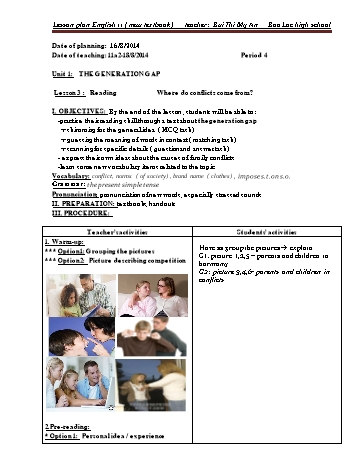Giáo án Tiếng Anh Lớp 11 - Tiết 4, Unit 1: The generation gap (Lesson 3: Reading) - Bùi Thị Mỹ An
Lesson 3 : Reading Where do conflicts come from?
I. OBJECTIVES: By the end of the lesson , students will be able to :
-practise their reading skill through a text about the generation gap
+ skimming for the general idea ( MCQ task)
+ guessing the meaning of words in context ( matching task)
+ scanning for specific details ( question and answer task)
- express their own ideas about the causes of family conflicts
-learn some new vocabulary items related to the topic
Vocabulary: conflict, norms ( of society) , brand name ( clothes) , impose s.t. on s.o.
Grammar: the present simple tense
Pronunciation: pronunciation of new words, especially stressed sounds
II. PREPARATION: textbooks, handouts
Bạn đang xem tài liệu "Giáo án Tiếng Anh Lớp 11 - Tiết 4, Unit 1: The generation gap (Lesson 3: Reading) - Bùi Thị Mỹ An", để tải tài liệu gốc về máy hãy click vào nút Download ở trên.
Tóm tắt nội dung tài liệu: Giáo án Tiếng Anh Lớp 11 - Tiết 4, Unit 1: The generation gap (Lesson 3: Reading) - Bùi Thị Mỹ An

Date of planning: 16/8/2014 Date of teaching: 11a2-18/8/2014 Period 4 Unit 1: THE GENERATION GAP Lesson 3 : Reading Where do conflicts come from? I. OBJECTIVES: By the end of the lesson , students will be able to : -practise their reading skill through a text about the generation gap + skimming for the general idea ( MCQ task) + guessing the meaning of words in context ( matching task) + scanning for specific details ( question and answer task) - express their own ideas about the causes of family conflicts -learn some new vocabulary items related to the topic Vocabulary: conflict, norms ( of society) , brand name ( clothes) , impose s.t. on s.o. Grammar: the present simple tense Pronunciation: pronunciation of new words, especially stressed sounds II. PREPARATION: textbooks, handouts III. PROCEDURE: Teacher’s activities Students’ activities 1. Warm-up: *** Option1: Grouping the pictures *** Option 2: Picture describing competition 2.Pre-reading: * Optio...4. Standards of behavior that are typical or accepted within a particular group or society. 5. situations in which people are involved in a serious disagreement or argument. 4. Post – reading: Pair work - discussion -have ss discuss the following 2 questions with a partner 1. Do you get into conflicts with your parents? 2. Share your experiences with your partners. 5.Homework: -have ss reread and redo the tasks -have ss do the exercises in section D- Speaking ( workbook , page 7) Have ss group the picturesà explain G1: picture 1,2,5 – parents and children in harmony G2: picture 3,4,6- parents and children in conflicts -work in pairs and share information Possible ideas: We often have different ideas about entertainment/ friends/ clothes - predict which ideas among those given they think may be found in the text Students’ own predictions -follow t’s introduction -read the text and answer the question 3 reasons - read the text and check their predictions à b,c,d,e,f - read the text and complete the table Areas of conflicts Parents’ thoughts Children’s thoughts The way parents treat their children They know what is best for their children They want to be more independent, create their own opinions and make their own decisions The clothes their children wear These clothes break rules and norms of society or distract them from schoolwork They want expensive, brand name clothes The way their children spend their free time They should spend their time in a more useful way They want to play computer games or chat online Their different interests They try to impose their choices of university or career on their children - read the text silently , practice asking and answering the questions 1. Because they strongly believe that they know what is best for their children. 2. They want to be more independent, create their own opinions and make their own decisions. 3. They are worried because these clothes break rules and norms of socie
File đính kèm:
 giao_an_tieng_anh_lop_11_tiet_4_unit_1_the_generation_gap_le.doc
giao_an_tieng_anh_lop_11_tiet_4_unit_1_the_generation_gap_le.doc

